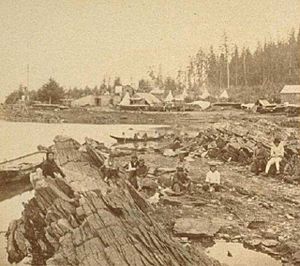Wrangell Bombardment facts for kids
Quick facts for kids Wrangell Bombardment |
|||||||
|---|---|---|---|---|---|---|---|
 View of Fort Wrangell under construction in background, Stikine in foreground, 1868 |
|||||||
|
|||||||
| Belligerents | |||||||
| Commanders and leaders | |||||||
|
|||||||
| Units involved | |||||||
| Detachment from Battery I, 2nd Regiment of Artillery | Irregular force of Stikine villagers, armed with muskets, spears, pistols. | ||||||
| Strength | |||||||
| 26 soldiers, log wall fort, 12-pounder mountain howitzer, 6-pounder cannon | 508 villagers | ||||||
| Casualties and losses | |||||||
|
|
||||||
The Wrangell Bombardment was a conflict that happened in 1869 in Wrangell, Alaska. The United States Army used cannons to fire on the village of Old Wrangell, which was home to the Stikine people. This event happened after a man named Scutd-doo killed Leon Smith, a former naval commander.
The army demanded that the Stikine villagers hand over Scutd-doo. After two days of fighting, Scutd-doo was given to the army. He was put on trial by the military and received the highest punishment. This was the first time such a punishment was carried out in Alaska under U.S. rule.
Contents
The Wrangell Bombardment: A Historical Event
The Wrangell Bombardment was a significant event in the early history of Alaska under U.S. control. It showed the tensions and misunderstandings that sometimes happened between the U.S. Army and the Native Alaskan people.
What Happened in Wrangell?
The conflict began with a series of events involving both U.S. soldiers and Stikine villagers. It quickly grew into a serious confrontation.
The Start of the Conflict
Before the bombardment, there was an argument involving Scutd-doo's son, Lowan. During this argument, Lowan caused an injury to the wife of a U.S. Army officer at Fort Wrangell. Because of this, soldiers killed Lowan. In return, Lowan's father, Scutd-doo, killed Leon Smith. The U.S. Army then demanded that Scutd-doo be handed over for justice.
The Bombardment and Its End
When the Stikine people did not immediately hand over Scutd-doo, the U.S. Army began firing cannons at the village. The villagers fought back with muskets. This exchange of fire lasted for two days. Eventually, the Stikine people gave Scutd-doo to the army. He was then put on trial by a military court. After the trial, he was given the highest punishment in front of both soldiers and villagers.
What Happened After the Bombardment?
The events at Wrangell had lasting effects and led to important discussions about how the U.S. Army should act in Alaska.
Lessons Learned from the Event
After the bombardment, Leon Smith's body was taken to San Francisco for burial. News of the event spread, and a full report was given to the President and Congress in 1870. This report came from the Board of Indian Commissioners, a group that advised the government on Native American affairs.
Later, legal experts decided that the army did not have the power to put civilians on trial in a military court and give them the highest punishment in Alaska. This meant that the army had acted beyond its legal authority in the Wrangell case.
A similar event happened in 1882, known as the Angoon Bombardment. In that incident, U.S. Navy forces destroyed the village of Angoon, Alaska. This happened after the Angoon Tlingit people demanded payment and took white hostages following an accidental death.
These conflicts, including the Wrangell Bombardment, showed that there were often misunderstandings between the Tlingit people and the U.S. soldiers. Some historians believe that the army's actions often made these situations worse.
Images for kids


